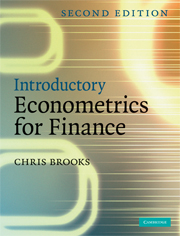Book contents
- Frontmatter
- Contents
- List of figures
- List of tables
- List of boxes
- List of screenshots
- Preface to the second edition
- Acknowledgements
- 1 Introduction
- 2 A brief overview of the classical linear regression model
- 3 Further development and analysis of the classical linear regression model
- 4 Classical linear regression model assumptions and diagnostic tests
- 5 Univariate time series modelling and forecasting
- 6 Multivariate models
- 7 Modelling long-run relationships in finance
- 8 Modelling volatility and correlation
- 9 Switching models
- 10 Panel data
- 11 Limited dependent variable models
- 12 Simulation methods
- 13 Conducting empirical research or doing a project or dissertation in finance
- 14 Recent and future developments in the modelling of financial time series
- Appendix 1 A review of some fundamental mathematical and statistical concepts
- Appendix 2 Tables of statistical distributions
- Appendix 3 Sources of data used in this book
- References
- Index
Preface to the second edition
- Frontmatter
- Contents
- List of figures
- List of tables
- List of boxes
- List of screenshots
- Preface to the second edition
- Acknowledgements
- 1 Introduction
- 2 A brief overview of the classical linear regression model
- 3 Further development and analysis of the classical linear regression model
- 4 Classical linear regression model assumptions and diagnostic tests
- 5 Univariate time series modelling and forecasting
- 6 Multivariate models
- 7 Modelling long-run relationships in finance
- 8 Modelling volatility and correlation
- 9 Switching models
- 10 Panel data
- 11 Limited dependent variable models
- 12 Simulation methods
- 13 Conducting empirical research or doing a project or dissertation in finance
- 14 Recent and future developments in the modelling of financial time series
- Appendix 1 A review of some fundamental mathematical and statistical concepts
- Appendix 2 Tables of statistical distributions
- Appendix 3 Sources of data used in this book
- References
- Index
Summary
Sales of the first edition of this book surpassed expectations (at least those of the author). Almost all of those who have contacted the author seem to like the book, and while other textbooks have been published since that date in the broad area of financial econometrics, none is really at the introductory level. All of the motivations for the first edition, described below, seem just as important today. Given that the book seems to have gone down well with readers, I have left the style largely unaltered and made small changes to the structure, described below.
The main motivations for writing the first edition of the book were:
To write a book that focused on using and applying the techniques rather than deriving proofs and learning formulae
To write an accessible textbook that required no prior knowledge of econometrics, but which also covered more recently developed approaches usually found only in more advanced texts
To use examples and terminology from finance rather than economics since there are many introductory texts in econometrics aimed at students of economics but none for students of finance
To litter the book with case studies of the use of econometrics in practice taken from the academic finance literature
To include sample instructions, screen dumps and computer output from two popular econometrics packages. This enabled readers to see how the techniques can be implemented in practice
To develop a companion web site containing answers to end-of-chapter questions, PowerPoint slides and other supporting materials.
Information
- Type
- Chapter
- Information
- Introductory Econometrics for Finance , pp. xix - xxiiiPublisher: Cambridge University PressPrint publication year: 2008
Accessibility standard: Unknown
Why this information is here
This section outlines the accessibility features of this content - including support for screen readers, full keyboard navigation and high-contrast display options. This may not be relevant for you.Accessibility Information
- 1
- Cited by
